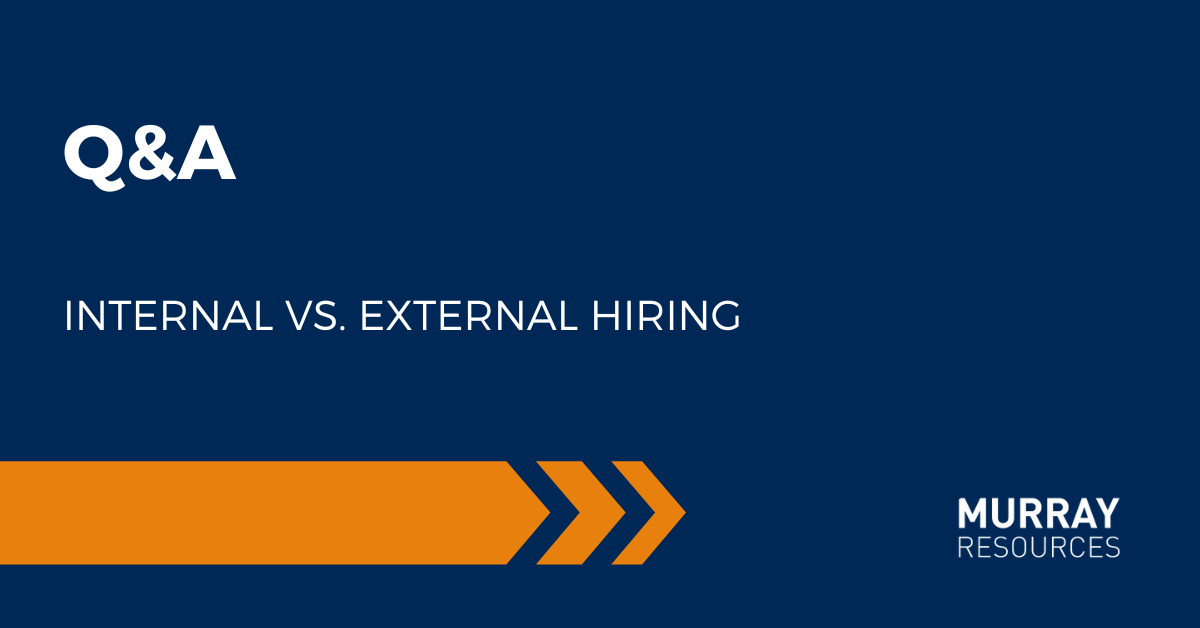Internal vs. External Hiring: Which Strategy Is Best for Growing Your Team?
July 15, 2025

When a new position opens up at your company, one question often rises to the top: should we hire from within or go outside the organization? This is not just a hiring decision, this is a strategic decision that can shape your team’s performance, morale, and long-term success.
At Murray Resources, we partner with companies across industries, and we’ve seen firsthand how the right hiring strategy can strengthen a team – and how the wrong one can slow down momentum. In a competitive job market, knowing when to hire internally and when to engage in external recruiting is essential for staying agile, innovative, and ahead of the curve.
In this blog, we’ll explore the pros and cons of internal recruitment and external recruiting, break down when to use each strategy, and share how combining both approaches can give your business a winning advantage.
Key Takeaways
- Hiring internally can improve morale, reduce onboarding time, and show employees that there’s room to grow.
- External recruiting brings fresh skills, new ideas, and access to a wider talent pool—ideal for hard-to-fill or growth roles.
- The most successful hiring strategies use both internal and external recruitment, depending on the position and business goals.
Why It Matters: Making the Right Hiring Decision

Your hiring process is more than just filling job openings – it’s about finding the right person who can thrive in the role and contribute to your company’s growth! Deciding between internal candidates and external candidates isn’t always clear-cut, but taking a thoughtful, strategic approach can save time, boost engagement, and ensure your team is set up for long-term success.
Each approach—hiring internally or externally—has a unique impact on team dynamics, company culture, and even your employer brand. And in today’s talent-driven market, how you hire speaks volumes about your values as a business.
Understanding the Benefits of Hiring Internally

Internal recruiting is the process of filling job openings with current employees – those who already understand your company’s culture, systems, and mission. Whether it’s a promotion to a leadership position, a lateral move to another department, or a shift into a new career path, internal hires give your organization the ability to grow talent from within.
For hiring managers, internal recruitment can be a game-changer. Instead of starting from scratch with an unfamiliar applicant pool, you’re engaging with individuals who’ve already proven themselves. You know their strengths, their work ethic, and how they collaborate across teams.
Hiring from within isn’t just convenient – it’s a strategic move with long-term value for both the company and the employee. Here’s how internal recruiting can positively impact your hiring process:
🔁 Faster, Smoother Onboarding
Because internal hires already know your tools, workflows, and organizational norms, they’re able to ramp up more quickly than external candidates. That means less downtime and faster results.
💡 Stronger Retention and Employee Loyalty
Employees who see clear growth opportunities are more likely to stay engaged – and stay with your company longer. Promoting from within shows your team that advancement is not only possible, but actively encouraged.
📊 Access to Proven Performance
Unlike external candidates, internal applicants come with a performance history. You know how they’ve handled pressure, contributed to the team, and met goals. This reduces the guesswork and leads to more informed hiring decisions.
💸 Lower Recruiting Costs
Internal recruiting significantly reduces expenses associated with hiring – from advertising and sourcing to background checks and onboarding. You’re investing in someone who already understands your business.
🏆 Positive Cultural Impact
When current employees see their peers being recognized and promoted, it reinforces a performance-driven culture. It also motivates others to grow and develop their own careers internally.
When Internal Recruitment Works Best:
- You’re filling leadership roles or roles that require deep company knowledge.
- You want to retain top talent and support employee development.
- You have strong internal pipelines and succession planning in place.
- The open role is a natural next step in someone’s career path.
The Potential Challenges of Hiring Internal Candidates

While internal recruiting offers powerful advantages, it’s not a perfect solution for every scenario. Even the most loyal and high-performing internal employees may not always be the right fit for every role. Understanding the potential challenges associated with hiring internally helps hiring managers set realistic expectations and make more strategic decisions – especially when balancing the needs of the role with the aspirations of the team. Let’s explore some of the common challenges to watch for:
🚨 Limited Talent Pool
Relying exclusively on internal hires can narrow your access to new perspectives, diverse experiences, and specialized skill sets. While promoting from within supports career growth, there may be times when your current team simply doesn’t have the qualifications required by the job description.
🔹Tip: To overcome this, regularly assess the skills available in-house and identify gaps. If you know a department is evolving, begin building those capabilities early – through learning programs, mentorship, or even cross-functional stretch assignments to encourage employees to develop new competencies!
🚨 Internal Competition and Morale Issues
When several internal employees express interest in the same role, things can get competitive – sometimes uncomfortably so. If the hiring process lacks clarity, transparency, or fairness, it can create frustration and resentment, especially among high-performing team members who aren’t selected.
🔹Solution: Hiring managers should clearly outline how decisions will be made. Posting a detailed job description internally and using structured interviews for all candidates—internal and external—helps set expectations. It also allows you to provide meaningful feedback to those not chosen, which can help encourage employees to stay engaged and continue growing toward future opportunities.
🚨 Backfilling the Original Role
When you promote an internal employee, their previous position still needs to be filled – often quickly. If there’s no plan in place, this can leave teams stretched thin or scrambling to cover responsibilities.
🔹Tip: Before finalizing an internal move, have a strategy for backfilling the role. Identify possible successors, open the position to other internal candidates, or engage in external recruiting if needed. A proactive plan ensures smoother transitions and keeps the business moving forward.
🚨Training and Upskilling Requirements
Some internal hires need additional support to succeed in more advanced roles. Without training or mentorship, even a strong internal employee may struggle to meet new expectations – especially if they’re transitioning into leadership for the first time.
🔹 Solution: Offer structured development opportunities that encourage employees to prepare for future growth. Leadership coaching, certification programs, and job shadowing are great ways to ready internal talent before roles even open up. This prepares them to step into new positions with confidence and competence.
🚨 Risk of Status Quo Thinking
While internal team members bring deep company knowledge, they may also be less likely to challenge old systems or introduce innovative solutions. Sometimes, what a role needs is a new perspective that only an outsider can bring.
🔹Solution: Encourage a culture of innovation by blending internal promotions with fresh external perspectives. For roles tied to transformation, change management, or growth into new markets, consider widening your search. Hiring managers can benefit from seeing both internal and external candidates side-by-side to choose the best fit based on the specific goals outlined in the job description.
By acknowledging these challenges early, companies can create a hiring process that supports both business needs and employee growth – ultimately leading to stronger teams and a more resilient workforce.
Exploring External Recruiting and It’s Benefits

External recruiting refers to the process of sourcing and hiring talent from outside your organization. This approach brings in professionals who aren’t currently part of your company but may have the skills, experience, and fresh perspective needed to help your team grow and evolve.
External hiring can be done through your internal HR department, job boards, employee referrals, or by partnering with a staffing and recruiting agency like Murray Resources (ready to hire a candidate now? Check out our website and get in contact with us today! ) Whether you’re scaling a team, entering a new market, or filling a highly specialized position, external candidates can provide critical value when your internal pipeline doesn’t have the right fit.
Unlike internal recruitment, which prioritizes familiarity and continuity, external recruiting focuses on expanding the possibilities – introducing new skills, different backgrounds, and diverse ways of thinking into your workforce. Bringing in new talent isn’t just about filling gaps – it’s a strategic opportunity to future-proof your business. Let’s get into the benefits of hiring externally:
🌍 Expanded Talent Pool
Hiring externally gives you access to a much larger group of candidates, including passive job seekers and professionals with unique backgrounds that don’t exist in your current workforce.
🚀 New Ideas and Skills
External hires can challenge the status quo, introduce new approaches, and fuel innovation—especially in departments that have become too insular.
⚖️ Equity and Fairness
An external search can promote greater inclusivity and objectivity, especially when you’re committed to building a more diverse team.
🎯 Specialized Expertise
When you’re filling a niche or technical role, external recruiting allows you to target professionals with specific certifications, tools, or industry know-how.
When External Recruiting Is the Better Option:
- The role requires experience or knowledge that no current employee has.
- You’re entering a new market, launching a new product, or scaling quickly.
- You want to diversify your team and bring in fresh perspectives.
- Internal candidates applied but didn’t meet the requirements.
The Potential Challenges of Hiring External Candidates

Hiring external candidates can unlock access to fresh perspectives, specialized expertise, and new energy – but it’s not without its complexities. Even when a candidate looks great on paper, external hiring can present its own set of challenges for hiring managers, teams, and company culture.
Understanding the potential pitfalls of external recruiting can help companies improve their hiring process, set realistic timelines, and make better-informed decisions – especially when balancing growth with cultural alignment. Here are some common challenges to watch for when bringing in external talent:
🚨 Longer Onboarding and Ramp-Up Time
Unlike internal employees, external hires need time to learn your company’s systems, tools, culture, and expectations. Even highly experienced professionals require a transition period, which can delay productivity.
🔹Tip: Set clear onboarding goals, assign a peer mentor, and provide role-specific training to help new hires ramp up faster. Proactive integration makes a big difference in retention and early performance.
🚨 Higher Costs
Hiring externally often comes with increased expenses—from advertising job openings and screening candidates to background checks, recruiter fees, and onboarding costs. The investment can be substantial, especially for specialized roles.
🔹Solution: Offset costs by streamlining your hiring process, setting budget expectations upfront, and working with a trusted staffing agency that can deliver pre-vetted candidates more efficiently.
🚨 Risk of Cultural Misalignment
Even when a candidate meets every qualification on the job description, there’s still a chance they may not mesh well with your company culture. Without the lived experience of being part of your team, cultural misfit is a risk.
🔹Tip: During the interview process, include culture-focused questions and involve cross-functional team members. Prioritize not just what candidates can do, but how they communicate, collaborate, and adapt to team dynamics.
🚨 Internal Pushback
When an external hire is chosen over internal candidates, it can lead to frustration or decreased morale – especially if team members were hoping for a promotion. Without transparency, it may feel like growth opportunities are being overlooked.
🔹Solution: Communicate clearly with internal candidates about why an external hire was made. Offer feedback, acknowledge their interest, and discuss potential growth paths. Encouraging employees to stay engaged shows you’re still invested in their future.
🚨 Uncertainty Around Performance
With external candidates, hiring managers don’t have a direct track record to reference. Even with strong resumes and interviews, there’s a risk that the candidate won’t deliver once in the role.
🔹Solution: Use structured interviews, behavioral assessments, and work samples to evaluate external applicants. Reference checks are also key – speak with previous managers to get a clearer picture of their work ethic and results.
🚨 Longer Time to Hire
Finding the right external candidate can take weeks—or even months—depending on the role. If the position is critical to business continuity, delays in hiring can create operational stress for the team.
🔹Tip: Partnering with a recruiting firm (like Murray Resources!) that understands your industry and culture can streamline sourcing, handle screening, and present top-tier candidates faster, saving you time and reducing the burden on internal HR.
Despite these challenges, external hiring remains one of the most effective ways to drive innovation, fill skill gaps, and support company growth. The key is alignment – making sure the role, the expectations, and the onboarding plan are clearly defined from day one.
How Internal and External Recruiting Can Work Together

The truth is, you don’t have to just choose one or the other. In fact, some of the best hiring outcomes come from combining both approaches!
👉 Here’s how a blended hiring strategy works in action:
- Post job openings internally first to give current employees a chance to apply. This shows your commitment to career growth and helps retain high-potential talent. It also helps you identify rising stars who may be ready for new challenges.
- If no internal candidates meet the qualifications outlined in the job description, expand the search externally. External recruiting brings in fresh energy, technical skills, and different experiences that may not exist within your current team.
- For key roles—like leadership positions, new market expansion, or technical specialties—consider launching both internal and external searches at the same time. This ensures you’re casting a wide net and building a robust pool of qualified applicants.
- Review data from previous hires to understand what’s worked best in the past. Which types of roles have been most successful when filled internally? Where has external hiring made the biggest impact? Use that insight to refine your strategy moving forward.
Common Mistakes in the Hiring Process (and How to Avoid Them)

Regardless of which route you choose, certain pitfalls can derail your hiring process if you’re not careful. Here are a few common missteps – and how to prevent them:
❌ Skipping Internal Review: Before going external, always assess your internal talent first. Skipping this step can signal to employees that growth isn’t prioritized.
❌ Vague Job Descriptions: Whether hiring internally or externally, clearly outlining the responsibilities and expectations for the role helps set the right tone and attract the right fit.
❌ Lack of a Proper Candidate Experience: Treat internal candidates with the same respect and communication as external ones. A negative experience—no matter who it’s with—hurts your employer brand.
❌ Bias Toward One Type of Candidate: Avoid favoring internal or external candidates by default. Evaluate each person on their own merit, not their source.
✅ Tips for Creating a Strong Internal Recruitment Program
Want to make hiring internally more effective? Start with these strategies:
- Develop Career Paths: Help employees understand how they can grow within the company.
- Train Your Managers: Equip leaders to identify and coach potential internal hires.
- Create Transparent Processes: Ensure every employee knows how to apply for job openings.
- Celebrate Internal Hires: Publicly acknowledge promotions and transitions to reinforce a culture of growth.
✅ Tips for External Hiring Success
External recruiting can be incredibly powerful when done well. Here’s how to improve your process:
- Work with a Trusted Staffing Partner: A firm like Murray Resources can help identify top candidates faster and more effectively than traditional methods.
- Use Targeted Outreach: Don’t just rely on job boards – tap into referrals, LinkedIn, and industry networks.
- Highlight Culture and Benefits: Remember, you’re not just evaluating candidates – they’re evaluating you, too.
- Move Quickly: Top external candidates don’t stay on the market for long. Speed matters.
Summary
At the end of the day, the best hiring strategy is a flexible one. Sometimes promoting from within is the right move. Other times, external recruiting is the only way to find the expertise you need. And often, the strongest approach is to do both – evaluating internal candidates while simultaneously looking outside your walls. By understanding when and how to use each strategy, your business can stay competitive, grow intentionally, and build a team that thrives.
Q&A

Q: What’s the main benefit of hiring internally?
A: Faster ramp-up time, stronger retention, and increased employee engagement.
Q: When should I consider external recruiting?
A: When the role requires specialized skills, you’re growing rapidly, or you want to add fresh perspectives to the team.
Q: How do I ensure fairness in the hiring process?
A: Be transparent about job openings, communicate clearly with all candidates, and evaluate based on skills—not familiarity.
Q: Can internal and external recruitment work together?
A: Absolutely. A hybrid strategy often delivers the best results.
Q: How can a staffing agency help with hiring?
A: Agencies like Murray Resources can provide vetted external candidates quickly—saving your team time, money, and effort.
Partner with Murray Resources to Strengthen Your Talent Strategy
If you’re struggling to fill open positions quickly or need help finding specialized talent, turn to Murray Resources. Our team of experienced recruiters has spent years building networks across industries, giving us the ability to find the perfect candidates for your company. Whether you need support for a time-sensitive search or want to supplement your internal recruiting efforts, we’re here to help. Take a look at our current job openings or contact us today to get started.
